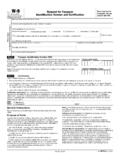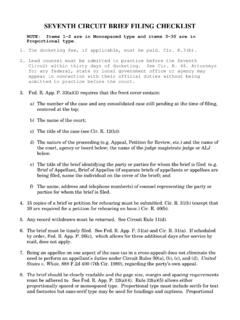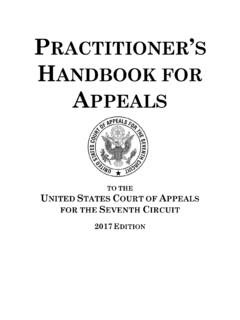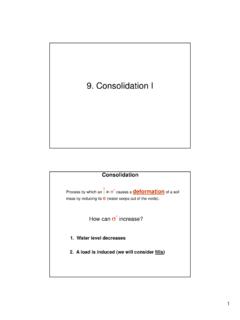Transcription of Pattern Criminal Federal Jury Instructions for the …
1 Pattern Criminal Federal Jury Instructionsfor theSeventh CircuitThe Committee on Federal Criminal Jury Instructions for the Seventh Circuit drafted theseproposed Pattern jury Instructions . The Seventh Circuit Judicial Council, on November 30,1998, approved these Instructions in principle and authorized their publication for use in theSeventh Judicial Council wishes to express its gratitude to the judges and lawyers who have workedso long and hard to make a contribution to our system of Criminal justice. TABLE OF CONTENTSINTRODUCTORY THE FUNCTIONS OF THE COURT AND THE THE TESTIMONY OF WITNESSES (DECIDING WHAT TO BELIEVE).. WEIGHING THE DEFINITION OF DIRECT AND CIRCUMSTANTIAL WHAT IS NOT ATTORNEY INTERVIEWING PARTY OTHER THAN AN NUMBER OF REMINDER OF VOIR DIRE THE CHARGE - THE LESSER INCLUDED PRESUMPTION OF INNOCENCE - BURDEN OF DEFINITION OF REASONABLE DEFINITION OF CRIME DEFINITION OF FELONY OR BILL OF FAILURE OF DEFENDANT TO DEFENDANT S POST-ARREST SILENCE IN THE FACE OF PROOF OF OTHER CRIMES OR IMPEACHMENT OF DEFENDANT - CHARACTER AND REPUTATION OF WEIGHING EXPERT CIRCUMSTANCES OF PRIOR INCONSISTENT STATEMENTS - PRIOR INCONSISTENT STATEMENTS - IMPEACHMENT OF WITNESS - CHARACTER OF A WITNESSES REQUIRING SPECIAL POSSESSION OF STOLEN
2 SUMMARIES - NOT RECORDINGS / TRANSCRIPTS OF FOREIGN LANGUAGE RECORDINGS / TRANSCRIPTS IN ENGLISH . DYING FALSE EXCULPATORY CHILD MISSING ELEMENTS OF OFFENSE - SINGLE OFFENSE ISSUES IN THE CASE AND BURDEN OF PROOF IN CASE INVOLVINGDEFENSE OF INSANITY .. UNANIMITY ON SPECIFIC DATE OF CRIME SEPARATE CONSIDERATION FOR EACH KNOWINGLY - SPECIFIC INTENT -- GENERAL DEFINITION OF PERSONAL RESPONSIBILITY OF CORPORATE ENTITY RESPONSIBILITY -- ENTITY DEFENDANT--AGENCY (a).. ENTITY RESPONSIBILITY-- ENTITY DEFENDANT--AGENCY (b).. JOINT ACTING THROUGH ANOTHER / AIDING AND ACCESSORY AFTER THE CONSPIRATOR S LIABILITY FOR SUBSTANTIVE CRIMESCOMMITTED BY CO-CONSPIRATORS; CONSPIRACY CONSPIRATOR'S LIABILITY FOR SUBSTANTIVE CRIMESCOMMITTED BY CO-CONSPIRATORS; CONSPIRACY NOTCHARGED IN THE INDICTMENT--ELEMENTS.
3 MERE PRESENCE / ASSOCIATION / CONSPIRACY - WITHDRAWAL - STATUTE OF SELF ENTRAPMENT - ENTRAPMENT - ENTRAPMENT - OPTIONAL ADDITIONS .. RELIANCE ON PUBLIC GOOD GOOD FAITH - INCOME TAX CASES .. BUYER-SELLER RELATIONSHIP .. SELECTION OF FOREPERSON -- GENERAL SELECTION OF FOREPERSON -- GENERAL VERDICT AS TO OFFENSECHARGED -- GENERAL VERDICT AS TO LESSER INCLUDED SEPARATE CONSIDERATION OF CHARGES - SINGLE DEFENDANT -MULTIPLE SEPARATE CONSIDERATION OF CHARGES - MULTIPLEDEFENDANTS -MULTIPLE COUNTS .. COMMUNICATION WITH DISAGREEMENT AMONG RETURN OF JURY AFTER ..10421 ..31926 ..33931 ..3641 INTRODUCTORY INSTRUCTIONSMany Instructions require the giving of additional or accompanying Instructions .
4 TheCommittee has tried to make explicit cross-references wherever possible, but gives no warrantythat it has done so exhaustively. In some circumstances, Instructions other than or in addition tothose referenced may be appropriate. These Instructions were drafted based on the most common factual and legal scenarios. The Committee anticipates that changes in the language of the Instructions may be appropriate inparticular cases. The Committee has drafted a separate instruction for use where the charge includesaiding and abetting or acting through another rather than including those possibilities in eachstatutory and sentences which appear in brackets ([ ]) are alternatives or additions toinstructions which are to be used when relevant to the particular case on THE FUNCTIONS OF THE COURT AND THE JURYM embers of the jury, you have seen and heard all the evidence and the arguments of theattorneys.
5 Now I will instruct you on the law. You have two duties as a jury. Your first duty is to decide the facts from the evidence inthe case. This is your job, and yours alone. Your second duty is to apply the law that I give you to the facts. You must follow theseinstructions, even if you disagree with them. Each of the Instructions is important, and you mustfollow all of them. Perform these duties fairly and impartially. Do not allow sympathy, prejudice, fear, orpublic opinion to influence you. [You should not be influenced by any person's race, color,religion, national ancestry, or sex.]Nothing I say now, and nothing I said or did during the trial, is meant to indicate anyopinion on my part about what the facts are or about what your verdict should be.
6 THE EVIDENCEThe evidence consists of the testimony of the witnesses, the exhibits admitted inevidence, and stipulations. A stipulation is an agreement between both sides that [certain facts are true] [that aperson would have given certain testimony].[I have taken judicial notice of certain facts that may be regarded as matters of commonknowledge. You may accept those facts as proved, but you are not required to do so.]Committee CommentRule 201 of the Federal Rules of Evidence governs judicial notice of adjudicative notice may be taken at any stage of the proceedings, but generally only after the partieshave been afforded an opportunity to be heard on the matter. Rule 201(g) requires the court incriminal cases to instruct the jury that it may, but is not required to, accept as conclusive anyfact judicially noticed.
7 TESTIMONY OF WITNESSES (DECIDING WHAT TO BELIEVE)You are to decide whether the testimony of each of the witnesses is truthful and accurate,in part, in whole, or not at all, as well as what weight, if any, you give to the testimony of evaluating the testimony of any witness, you may consider, among other things:[- the witness's age;]- the witness's intelligence;- the ability and opportunity the witness had to see, hear, or know the things thatthe witness testified about;- the witness's memory;- any interest, bias, or prejudice the witness may have; - the manner of the witness while testifying; and- the reasonableness of the witness's testimony in light of all the evidence in thecase. [You should judge the defendant's testimony in the same way that you judge thetestimony of any other witness.]
8 ]Committee CommentThe portion of the instruction relating to age should be given only when a very elderly ora very young witness has bracketed final sentence should be given only when a defendant WEIGHING THE EVIDENCE-INFERENCESYou should use common sense in weighing the evidence and consider the evidence inlight of your own observations in our lives, we often look at one fact and conclude from it that another fact exists. Inlaw we call this inference. A jury is allowed to make reasonable inferences. Any inferencesyou make must be reasonable and must be based on the evidence in the CommentWhile the term inference is not used in common parlance, it was retained here, anddefined, as a shorthand in order to avoid the need to repeat the same point elsewhere in DEFINITION OF DIRECT AND CIRCUMSTANTIAL EVIDENCESome of you have heard the phrases circumstantial evidence and direct evidence.
9 Direct evidence is the testimony of someone who claims to have personal knowledge of thecommission of the crime which has been charged, such as an eyewitness. Circumstantialevidence is the proof of a series of facts which tend to show whether the defendant is guilty ornot guilty. The law makes no distinction between the weight to be given either direct orcircumstantial evidence. You should decide how much weight to give to any evidence. All theevidence in the case, including the circumstantial evidence, should be considered by you inreaching your CommentThe phrase circumstantial evidence is addressed here because of its use in commonparlance and the likelihood that jurors may have heard the term outside the may be cases where a more explicit comparison of direct and circumstantialevidence would be helpful.
10 In such cases, the Court may give examples, , direct proof that itis raining is the testimony of a witness, I was outside a minute ago and I saw it raining ;circumstantial evidence that it is raining is the sight of someone entering the courtroom carryinga wet umbrella. WHAT IS NOT EVIDENCEC ertain things are not evidence. I will list them for you:First, testimony [and exhibits] that I struck from the record, or that I told you todisregard, is [are] not evidence and must not be considered. Second, anything that you may have seen or heard outside the courtroom is not evidenceand must be entirely disregarded. [This includes any press, radio, or television reports you mayhave seen or heard. Such reports are not evidence and your verdict must not be influenced inany way by such publicity.]









